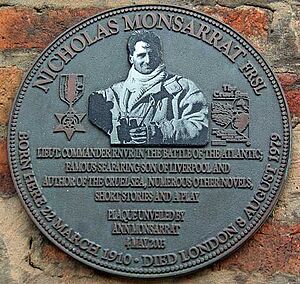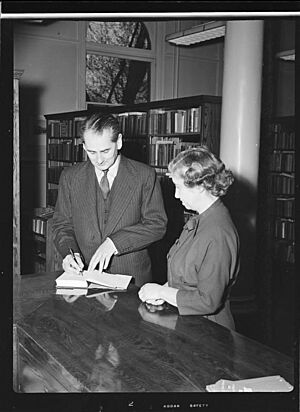Nicholas Monsarrat facts for kids
Quick facts for kids
Nicholas Monsarrat
FRSL RNVR
|
|
|---|---|

Commemorative plaque on Rodney Street, Liverpool
|
|
| Born | Nicholas John Turney Monsarrat 22 March 1910 Liverpool, England |
| Died | 8 August 1979 (aged 69) London, England |
| Occupation | Lawyer, writer, sailor |
| Language | English |
| Nationality | English |
| Alma mater | Trinity College, Cambridge University |
| Genre | Maritime fiction |
| Years active | 1934–1979 |
| Notable works | The Cruel Sea |
| Spouse | Eileen Rowland, Phillipa Crosby, and Ann Griffiths |
| Children | Marc, Anthony, and Max |
Lieutenant Commander Nicholas John Turney Monsarrat (born March 22, 1910 – died August 8, 1979) was a famous British writer. He was best known for his exciting stories about the sea. His most famous books include The Cruel Sea and Three Corvettes. He also wrote popular novels like The Tribe That Lost Its Head.
Contents
Growing Up
Nicholas Monsarrat was born in Liverpool, England. His father, Keith Waldegrave Monsarrat, was a very skilled surgeon. Nicholas went to Winchester College and then to Trinity College, Cambridge, for his education.
He first planned to become a lawyer. However, he soon decided he wanted to be a writer instead. He moved to London and started writing for newspapers. Between 1934 and 1939, he wrote four novels and a play.
Serving in World War II
Even though Nicholas Monsarrat did not like military violence, he joined the war effort. He first worked with an ambulance team. Later, he joined the Royal Naval Volunteer Reserve (RNVR). He loved sailing, which made him a good naval officer.
He served on small warships called corvettes and frigates. His job was to protect convoys, which were groups of ships traveling together. These convoys carried important supplies and needed protection from enemy attacks. Monsarrat used his experiences from the war in his famous sea stories.
After the war ended in 1946, Monsarrat left the navy. He then worked in the diplomatic service. This meant he represented Britain in other countries. He was posted in Johannesburg, South Africa, and later in Ottawa, Canada. In 1959, he decided to write full-time. He lived on the island of Guernsey and later on Gozo, which is part of Malta.
His Ranks and Ships
During his time in the navy, Nicholas Monsarrat moved up in rank:
- July 1940: Sub-Lieutenant
- October 1940: Lieutenant
- December 1943: Lieutenant Commander
He served on several ships, often as the First Lieutenant or Commanding Officer. Some of the ships he wrote about in his books used different names for security reasons during the war. For example, his first ship, HMS Campanula, was called "HMS Flower" in his stories.
His Books and Stories
Monsarrat's first few novels, written in the 1930s, looked at social problems. His book This Is the Schoolroom was partly about his own life. It told the story of a young writer seeing the world for the first time.
The Cruel Sea (1951) is seen as his best work. It is still widely read today. The story is based on his own time in the navy during World War II. It follows a young officer named Keith Lockhart on his journey through the war at sea. The book showed how dangerous the sea itself could be, not just the enemy. His short story collections, HMS Marlborough Will Enter Harbour and The Ship That Died of Shame, also became popular because of The Cruel Sea.
His book Three Corvettes (1945) is a collection of three true stories from his war experiences. He used made-up names for the ships in these stories because of wartime security. For example, HMS Guillemot was called Dipper.
Monsarrat also wrote novels based on his time in the diplomatic service. The Tribe That Lost Its Head (1956) and Richer Than All His Tribe (1968) are examples. These books explored Britain's colonial past in Africa. Some of his other books, like The Nylon Pirates, also had connections to the sea. The Kappillan of Malta told the story of a priest on the island of Malta during World War II.
The Story of Esther Costello (1952) was another notable book. It was later made into a movie. This book showed how some people might take advantage of good causes for money.
His last book, The Master Mariner, was not finished when he died. It was a historical novel about a 16th-century sailor. This sailor was cursed to sail the seas forever as punishment for being a coward. Through this character, Monsarrat showed the important role of sailors throughout history.
About His Life
Nicholas Monsarrat wrote two non-fiction books about his own life. They were called Life is a Four Letter Word: Breaking In (1966) and Life is a Four Letter Word: Breaking Out (1970). These books tell his life story.
His Final Journey
Nicholas Monsarrat passed away from cancer on August 8, 1979, in London. He wished to be buried at sea. The Royal Navy helped make this happen. His casket was placed into the sea from the ship HMS Scylla.
Movies Based on His Books
Several of Nicholas Monsarrat's books have been made into movies:
- The Cruel Sea (1953), starring Jack Hawkins.
- The Ship That Died of Shame (1955), starring Richard Attenborough.
- HMS Marlborough Will Enter Port (1956), a TV film narrated by Ronald Reagan.
- The Story of Esther Costello (1957), starring Joan Crawford.
- Bait for the Tiger (1957), a television film.
- Something to Hide (1972), starring Peter Finch.
- The Reconciliation (1984), a TV film.


